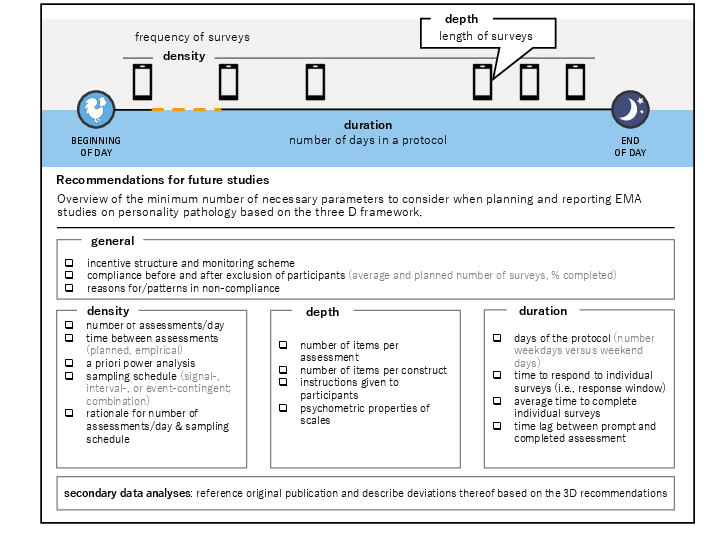STRESSY: Systematic Review of Ecological Momentary Assessment Studies on Stress in the Daily Lives of Youth
PI: Paula Philippi
Collaborator: Laura Meine, University of Zurich
Project Duration: 10/2023-06/2024
Preregistration: https://osf.io/cxpmw
Stress represents a transdiagnostic risk factor key to the genesis of numerous psychological disorders, many of which debut during childhood or adolescence (McMahon et al., 2003). Stress is associated with youth depression (e.g., Vrshek-Schallhorn et al., 2015), anxiety (Allen, Rapee, & Sandberg, 2008), broad internalizing (Zandstra et al., 2015) and externalizing problems (Zandstra et al., 2015). Moreover, youth with depression and anxiety engage in behaviors and select environments that lead to stress (Hammen et al., 2012). These associations suggest that stress-related processes may confer risk for, and also be generated by common psychopathology.
Process-based accounts of psychopathology (Wright & Kaurin, 2020) shift the focus of psychopathology research to intra-individual processes that unfold in transaction with the environment (Baumert et al., 2017; Vize, Kaurin, & Wright, 2021). Ecological momentary assessment (EMA) tools are one promising avenue to develop transdiagnostic symptom profiles and within-person processes relevant to mental health outcomes in youth.
Over the past two decades there has been a surge of interest in using EMA to study dynamic processes in daily life across the psychological sciences (Hamaker & Wichers, 2017) including the study of psychopathology in youth (Wen et al., 2017; Heron et al., 2017). EMA affords key benefits, most notably increased ecological validity, reduced retrospective bias, and the ability to sample various points along a process (Shiffman et al., 2008). Thus, EMA allows researchers to better harmonize theory, data acquisition, and statistical models of youth psychopathology. To date, however, there is a lack of comprehensive synthesis in EMA research, particularly in child and adolescent samples. Existing reviews have mainly focused on critical EMA protocol design issues, aiming to offer guidelines for best practices in planning and conducting EMA studies with clinical samples (Wen et al., 2017; Heron et al., 2017).
Due to the transdiagnostic value of stress processes, the aim of this work is to provide a systematic overview of how stress is operationalized and quantified in the daily lives of youth via EMA designs. This includes descriptive aspects such as item semantics, the variability of daily stress, the frequency/prevalence of assessed stressors (see Figure 1 for an overview), as well as the identification of relationships and covariations between stress indices and mental health outcomes. We intend not only to report on the current state of the literature but also to address emerging challenges of real-time assessments of stress in children and adolescents, ultimately deriving recommendations for future studies.

Figure 1. Source: Kaurin et al., 2023
References
Allen, J. L., Rapee, R. M., & Sandberg, S. (2008). Severe life events and chronic adversities as antecedents to anxiety in children: A matched control study. Journal of abnormal child psychology, 36, 1047-1056.
Baumert, A., Schmitt, M., Perugini, M., Johnson, W., Blum, G., Borkenau, P., ... & Wrzus, C. (2017). Integrating personality structure, personality process, and personality development. European Journal of Personality, 31(5), 503-528.
Hamaker, E. L., & Wichers, M. (2017). No time like the present: Discovering the hidden dynamics in intensive longitudinal data. Current Directions in Psychological Science, 26(1), 10-15.
Hammen, C., Hazel, N. A., Brennan, P. A., & Najman, J. (2012). Intergenerational transmission and continuity of stress and depression: Depressed women and their offspring in 20 years of follow-up. Psychological medicine, 42(5), 931-942.
Heron, K. E., Everhart, R. S., McHale, S. M., & Smyth, J. M. (2017). Using mobile-technology-based ecological momentary assessment (EMA) methods with youth: A systematic review and recommendations. Journal of pediatric psychology, 42(10), 1087-1107.
Kaurin, A., King, K. M., & Wright, A. G. (2023). Studying personality pathology with ecological momentary assessment: Harmonizing theory and method. Personality Disorders: Theory, Research, and Treatment, 14(1), 62.
McMahon, S. D., Grant, K. E., Compas, B. E., Thurm, A. E., & Ey, S. (2003). Stress and psychopathology in children and adolescents: is there evidence of specificity?. Journal of Child Psychology and Psychiatry, 44(1), 107-133.
Vize, C. E., Kaurin, A., & Wright, A. G. (2021). Personality Pathology and Momentary Stress Processes. Clinical Psychological Science, 21677026231192483.
Vrshek-Schallhorn, S., Stroud, C. B., Mineka, S., Hammen, C., Zinbarg, R. E., Wolitzky-Taylor, K., & Craske, M. G. (2015). Chronic and episodic interpersonal stress as statistically unique predictors of depression in two samples of emerging adults. Journal of Psychopathology and Clinical Science, 124(4), 918.
Wen, C. K. F., Schneider, S., Stone, A. A., & Spruijt-Metz, D. (2017). Compliance with mobile ecological momentary assessment protocols in children and adolescents: a systematic review and meta-analysis. Journal of medical Internet research, 19(4), e132.
Wright, A. G., & Kaurin, A. (2020). Integrating structure and function in conceptualizing and assessing pathological traits. Psychopathology, 53(3-4), 189-197.
Zandstra, A. R. E., Hartman, C. A., Nederhof, E., van den Heuvel, E. R., Dietrich, A., Hoekstra, P. J., & Ormel, J. (2015). Chronic stress and adolescents’ mental health: modifying effects of basal cortisol and parental psychiatric history. The TRAILS study. Journal of Abnormal Child Psychology, 43, 1119-1130.
Last modified: 27.02.2025
